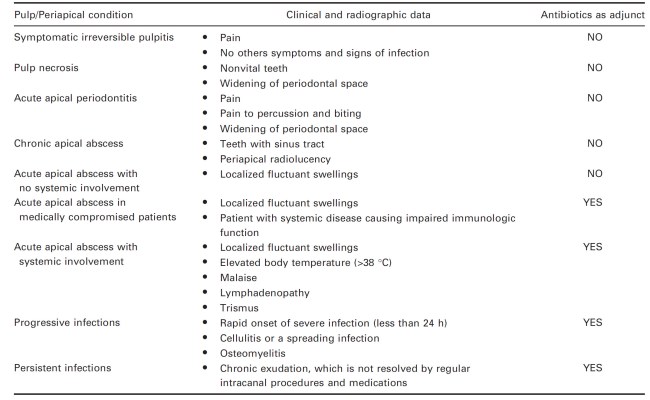Over-using antibiotics is a global concern due to the emergence of more antibiotic resistant bacterial strains. In dentistry, patients suffering from odontogenic related pain and infections are often prescribed broad spectrum antibiotics when these are not indicated.
15% of GDP’s in the UK prescribe antibiotics every day! And 40% prescribe at least 3x weekly! (Lewis 2008)
So what are the indications of antibiotics in dentistry?
For endodontic related pain and swellings, the primary aim is to establish a pathway for drainage either via the soft tissues or through opening the root canal system. Systemic antibiotics are used as an adjunct to this if required (see the table above). This article doesn’t cover topical antibiotic use which may be indicated for a variety of dental treatments including pulp-capping, root canal treatment, regenerative endodontic procedures etc.
The key point here is to prescribe antibiotics when there is systemic involvement and progressive/persistent infection. Medically/immune compromised patients are more susceptible to developing complications from odontogenic infections; antibiotics may be considered as an adjunct in these patients as well. See the table below for a summary:
Table (Antibiotics in Endodontics, a review)
What to prescribe?
Amoxicillin
- Moderate spectrum covers many endodontic pathogens
- 8% of population is allergic
- Many people think they are allergic when it is usually intolerance symptoms
- Better absorbed than Penicillin
- Better than Penicillin for gram Negative spectrum
- Sometimes Augmented with Clavulanic Acid to prevent degradation and increase effectiveness against Staph Aureus (mainly for immunocompromised patients/second line of treatment)
Penicillin V
- Narrow spectrum
- Not well absorbed, almost 70% in oral dose is wasted
- Diarrhoea is a frequent side effect
- Very short term acting medication
- 8% population allergic
Clindamycin
- Kills micro-organisms by blocking ribosomes
- Effective bone concentration is same as that in plasma – therefore effective tissue distribution
- Good alternative for patients allergic to Penicillin or second line of treatment
Metronidazole
- Effective against an-aerobic bacteria
- Ineffective against facultative species and aerobes
- Works well as a supplemental antibiotic to Amoxicillin (American Ascociation of Endodontics 1999)
- A common indication is in pericoronitis cases that have caused trismus and lymphadenopathy
Clarithromycin
- Effective against aerobic, anaerobic, gram + and –
- Good alternative to Amoxicillin for allergic patients
Tetracycline/Doxycycline
- Indicated as an adjunct to replantation of avulsed teeth (IADT Guidelines)
This article mainly discusses the indications for systemic antibiotics for odontogenic pain. As mentioned previously, there may be other genuine indications for their use in other situations e.g. re-implanted teeth, severe medically compromised patients on a case to case basis etc.
#AntibioticAwareness Resources
References
Lewis MAO (2008) Why we must reduce dental prescription of antibiotics: European Union Antibiotics Awareness Day. British Dental Journal 205, 537-8.
, , , , , , , , . Antibiotics in Endodontics: a review. International Endodontic Journal, 50, 1169–1184, 2017.

